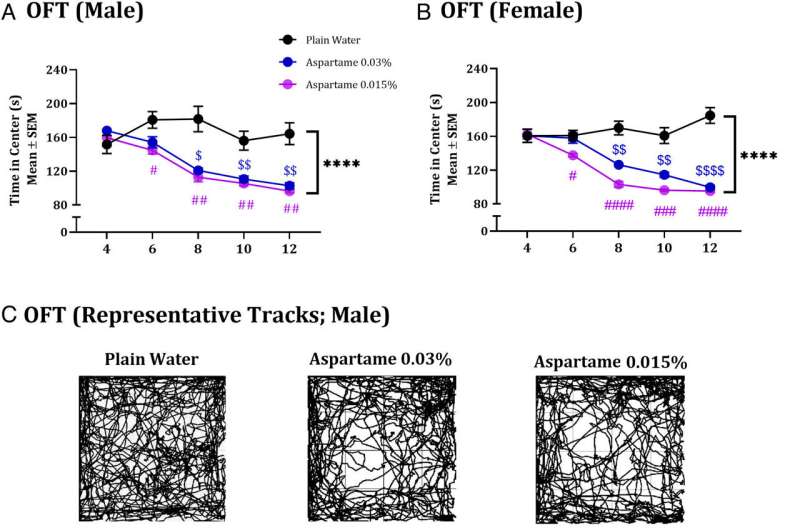Anxiety and its response to diazepam in mice exposed to aspartame-containing drinking water. Anxiety-like responses were analyzed in male and female mice exposed daily to drinking water containing 0.03% aspartame, 0.015% aspartame or to plain drinking water for 12 wk using open field test (OFT; A and B) and elevated zero maze (EZM; D). In the OFT analysis (A and B), two-way ANOVA showed that male (A) and female (B) mice in the 0.03% aspartame group (blue line) and 0.015% aspartame (purple line) groups spent significantly shorter time in the center areas in the OFT compared to their counterparts in the plain drinking water (black) group (**** in A and B). Dunnett's multiple comparisons test showed that significant differences emerged between 0.015% aspartame and plain water groups at 6 wk in males and females and persisted at 8 wk, 10 wk, and 12 wk (A and B). Significant differences between 0.03% aspartame and plain water groups emerged at 8 wk in males and females and persisted at 10 wk and at 12 wk (A and B). Typical tracks of open field exploration by one male mouse in each of the plain water, 0.03% aspartame and 0.015% aspartame groups showing differences in exploration of the center areas (C). The male and female mice in the 0.015% aspartame and plain water groups were examined in the EZM (D). Two-way ANOVA of the EZM data showed no significant effect of sex (E). Therefore, the data from male and female mice were analyzed together. The aspartame group spent significantly shorter time in the open areas of the EZM (E). Response of male and female mice in the 0.03% aspartame group to diazepam was analyzed in the OFT (E). Initially, baseline parameters were established 30 min following a single intraperitoneal administration of saline. Next, 48 h. later, the same mice received diazepam (3 mg/kg, i.p.) and 30 min following the diazepam administration, the mice were re-examined in the OFT (E). Repeated Measures ANOVA showed no significant effect of sex (E). Therefore, data from male and female mice were combined and analyzed. The time spent in the center areas was significantly increased following the diazepam administration compared to the saline administration at baseline (E). Typical tracks of open field exploration by one male mouse each in the saline and diazepam groups (F). Notes on symbols: # = comparison between 0.015% aspartame and plain water group; $ = comparison between 0.015% aspartame and plain water group. #; $ = P < 0.05; ##; $$ = P < 0.01; ###; $$$ = P < 0.001; ****, ####; $$$$ = P < 0.0001. Credit: Proceedings of the National Academy of Sciences (2022). DOI: 10.1073/pnas.2213120119
Florida State University College of Medicine researchers have linked aspartame, an artificial sweetener found in nearly 5,000 diet foods and drinks, to anxiety-like behavior in mice.
Along with producing anxiety in the mice who consumed aspartame, the effects extended up to two generations from the males exposed to the sweetener. The study is published in the Proceedings of the National Academy of Sciences.
"What this study is showing is we need to look back at the environmental factors, because what we see today is not only what's happening today, but what happened two generations ago and maybe even longer," said co-author Pradeep Bhide, the Jim and Betty Ann Rodgers Eminent Scholar Chair of Developmental Neuroscience in the Department of Biomedical Sciences.
The study came about, in part, because of previous research from the Bhide Lab on the transgenerational effects of nicotine on mice. The research showed temporary—or epigenetic—changes in mice sperm cells. Unlike genetic changes (mutations), epigenetic changes are reversible and don't change the DNA sequence; however, they can change how the body reads a DNA sequence.
"We were working on the effects of nicotine on the same type of model," Bhide said. "The father smokes. What happened to the children?"
The U.S. Food and Drug Administration (FDA) approved aspartame as a sweetener in 1981. Today, nearly 5,000 metric tons are produced each year. When consumed, aspartame becomes aspartic acid, phenylalanine and methanol, all of which can have potent effects on the central nervous system.
Led by doctoral candidate Sara Jones, the study involved providing mice with drinking water containing aspartame at approximately 15% of the FDA-approved maximum daily human intake. The dosage, equivalent to six to eight 8-ounce cans of diet soda a day for humans, continued for 12 weeks in a study spanning four years.
Pronounced anxiety-like behavior was observed in the mice through a variety of maze tests across multiple generations descending from the aspartame-exposed males.
"It was such a robust anxiety-like trait that I don't think any of us were anticipating we would see," Jones said. "It was completely unexpected. Usually you see subtle changes."
When given diazepam, a drug used to treat anxiety disorder in humans, mice in all generations ceased to show anxiety-like behavior.
Researchers are planning an additional publication from this study focused on how aspartame affected memory. Future research will identify the molecular mechanisms that influence the transmission of aspartame's effect across generations.
Other co-authors were Department of Biomedical Sciences faculty members Deirdre McCarthy, Cynthia Vied and Gregg Stanwood, and FSU Department of Psychology Professor Chris Schatschneider.
More information: Sara K. Jones et al, Transgenerational transmission of aspartame-induced anxiety and changes in glutamate-GABA signaling and gene expression in the amygdala, Proceedings of the National Academy of Sciences (2022). DOI: 10.1073/pnas.2213120119
Journal information: Proceedings of the National Academy of Sciences
Provided by Florida State University






















